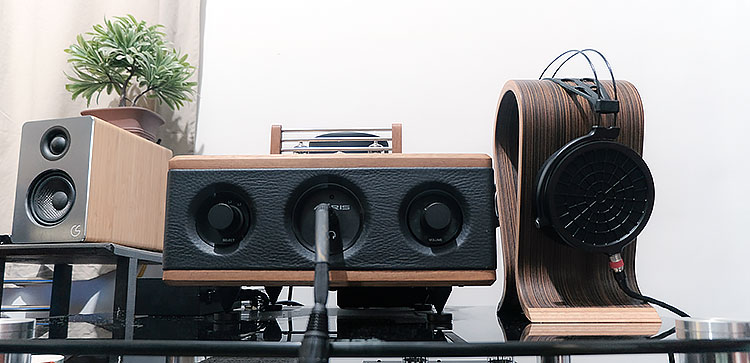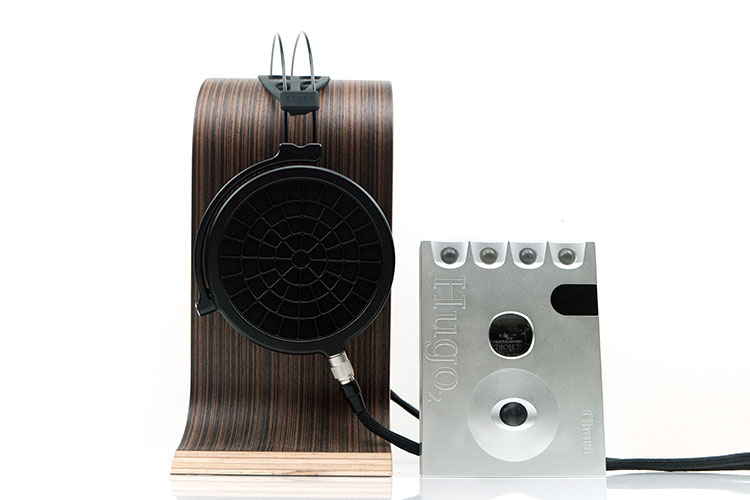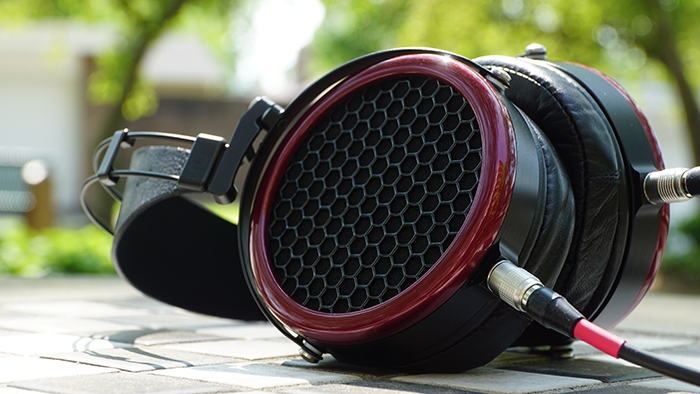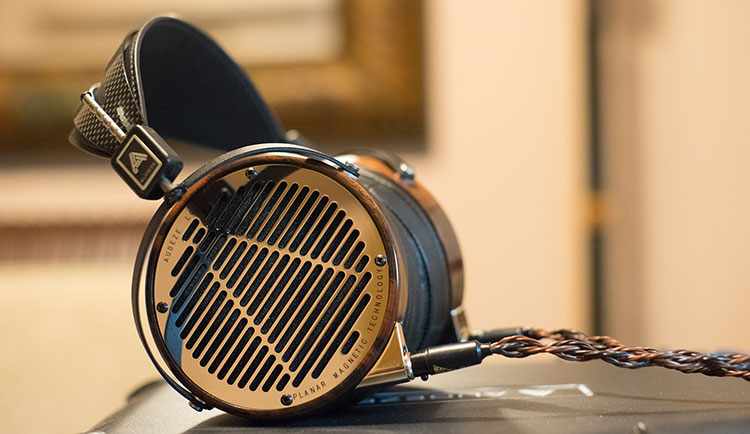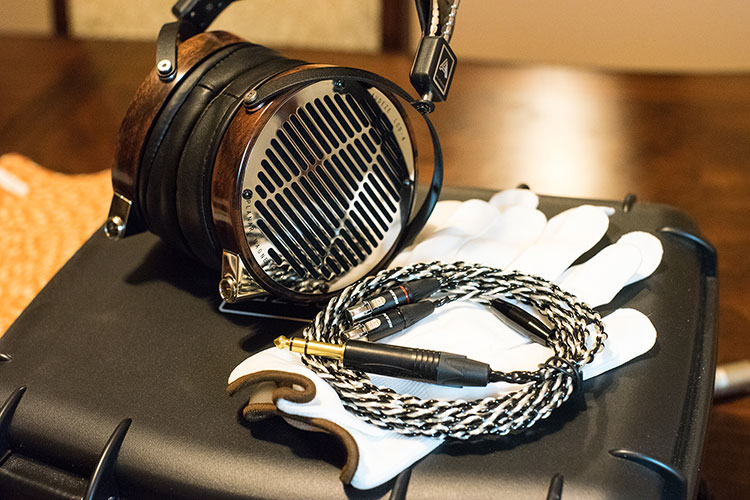Sound Impressions
Summary
The Ether 2 is not an evolution of the Ether ‘O’ sound nor is it a tweak of the Ether Flow sound. No sir! This is a complete reimagination of what the Ether line presentation stands for with a signature that I believe was alluded to slightly with the VOCE but now even more pronounced with the Ether 2.
Tone
The tone is neutral to slightly warm, more intimate than expansive but within that staging, the background is really black with some excellent instrumental separation and above average imaging. For those concerned that the treble may lack weight or seem a little hard sounding can relax. The Ether 2 top-end is smooth, full-bodied and slightly to the wet side though not as sparkling as previous versions. You will find the overall presentation full-bodied and at times energetic and powerful yet still forgiving and very smooth, particularly with female vocals.
Response
This is one heck of a linear sounding planar headphone. If you want to understand just how steady and pure its low-end to midrange is then just grab some measurements and take a look. It is rock solid on ours up to around 1-2k, perhaps even as far as 2k. We couldn’t detect any major bumps from 20Hz to around 1-2k where it starts to take an expected dip to 3-4k. Even then this is not a huge dip.
The response behavior is impeccably controlled throughout the bass and mids. If there is anything to discern from the Ether 2 curve is just that there is a slight sub-bass bias and a very gentle but linear drop to the mids. It is a contributing factor to the slightly more aggressive and more powerful low-end of the Ether 2 compared to the gentler warmth or mid-bass bloom of the original Ether.
Staging
There is more depth than height to the Ether 2 soundstage. It is not the airiest of presentations but it is definitely more natural and open sounding than the original Ether. I hesitate to say ‘great width’ because contextually it is not as open sounding as say the Susvara or even the HE1000 but at the same time, you never feel it is congested.
Quite the opposite actually. It does great things with its width would be the more accurate statement with some stellar left-right separation and what I believe is a much-improved transient response over the older driver. It paints a much more vivid and holographic soundstage than before.
Bass
One of the most linear sounding planar bass responses I have heard at this price point. There is a slight sub-bass bias but you are talking maybe 1-2dB drop to 1k at most and certainly zero roll-off so its rock solid right down to 20Hz.
More than that, its pacy with excellent layering and dynamic range. This is not an ‘always-on’ heavy-handed slow as a molasses low-end blob of bass. It will add a solid bass fundamental when needed and with excellent definition. This is especially so in its sub-bass presence where the original Ether lacked a little muscle.
And it shows in just about everything I threw at it. Synth-wave tracks, in particular, such as Deadline’s mid-paced cruncher ‘Deviant‘ from their Bionic Chrysalis album has some excellent bass presence yet at the same time enough of a black background and a natural decay to hold an incredibly solid level of definition and not muddy up the lower-mids unnecessarily.
Adrenaline Mob’s Psychoinsane rhythm guitar links from their Omerta album is a lovely example of how the Ether 2’s low-end adds just enough bass fundamental and body to chugging guitar rifts without smoothing over the detail.
Mids
The Ether 2 remains perfectly linear up to around 1-2k before it takes a ‘normal’ dip to 3-4k and the rises out of the upper mids into the lower treble but not by a huge amount. There is a little bias to the lower-mids instrumental presence with a neutral vocal positioning. I find the likes of the LCD-4 to have a bit more lower-pitched vocal spacing with its more elevated 500Hz to 1k presence but it also sounds a little thinner in its vocal timbre than the Ether 2.
The Ether 2 vocals are full-bodied and rich in texture, especially midrange female voicing. I would not call it a euphonic midrange though. Instrumental and vocal timbre do not sound overly rounded or romantic, not by a long shot.
Simply put, partial overtones and sharp sounding nasties are absent throughout keeping the signature very smooth and even sounding. That steely tone that can often infect planar vocal ranges such as the LCD-4 and its overly odd-harmonic presence in its percussion timbre is not happening here. You could argue that the relaxed treble sound does dial down the upper mids percussion presence a bit but I can live with that in return for that wetter and smooth performance.
Treble
The treble performance of the Ether 2 is much more coherent and physical sounding than the original Ether. Lower treble up to 5-6k seems very evenly balanced for me with a slight dip around 7k and an 8k bump roughly in line with the 5k peak. Nothing feels overly exaggerated.
The Ether 2 might lack a little presence compared to first Ether and may seem a touch warmer though no less detailed. That accusation that the Ether could lack a little body up top in favor of sparkle making it an overly lean treble sound is definitely gone with the Ether 2.
However, you need to carefully match your setup to maximize the sparkle and subsequent snap in its higher pitched instrumental timbre. I would veer to neutral sources and solid-state amps to prevent it from sounding overly soft.
Matchability
Efficiency
The Ether 2 is rated at 16Ω but with no SPL rating officially published, at least not on their website. What I can tell you from our testing that it is not quite as sensitive as the older Ether non-Flow or ‘O’ edition on the desktop amps we tested to date. This is a 23Ω, 96dB SPL rated model.
We did find the Hifiman HE1000 SE to be slightly less efficient than the Ether 2 which is rated at 35Ω and 90dB so we feel the Ether 2 probably has an SPL of around 92-94dB.
For the Audeze LCD-4, it was a mixed bag of results when compared to the Ether 2. On the fixed impedance output of the Xi Audio Formula S, the Ether 2 was much easier to drive than the LCD-4. However, on the 200Ω setting of the Auris HA-2SE, the LCD-4 opened up quite a lot. It was actually the more sensitive of the two headphones on the single-ended output once the amp was evenly matched to the impedance rating of the LCD-4.
Synergy Preferences
I almost always used the Ether ‘O’ with a tube amp or a sweeter sounding solid-state amp if none was available. That harder edged treble quality of the original Ether generally took on a slightly wetter and smoother sound which can often suit my hard-rocking high percussion energy tastes.
With the Ether 2, I found myself going in a different direction with solid-state energetic amplifier signatures. As much as possible I did not want to soften the already smooth sound of the Ether 2 so amps like the HA-2SE where edged out by the likes of the Formula S. DAC’s such as the Chord Qutest/Hugo 2 and Oppo Sonica with their neutral and very revealing signatures made fantastic source pairings also.
The key for me was not so much to produce a dry, neutral or bright tone or offset the slightly warmer ambiance of the Ether 2. Rather it was to emphasize the stellar openness and dynamic range of the Ether 2’s performance and extract as much detail as possible.
Auris HA-2SE (Hugo 2 DAC)
With the HA-2SE I loved the tone with the Ether 2 a lot. This is a very nice meaty and rich sounding timbre but is also a little too intimate and rounded sounding. I felt the strong imaging of the Ether 2 deserved a little more openness to perform.
Cayin iHA-6 (Hugo 2 DAC)
The Cayin iHA-6 will deliver a much drier tone and a lot more treble presence than the HA-2SE. It is not quite as rich sounding but it is energetic and quite impactful. I actually felt this pairing was very neutral and down the line and should please those looking for a little more treble energy.
Xi Audio Formula S (Hugo 2 DAC)
This was my Zen amp and the perfect balance with the Ether 2. Not only was it much more open sounding than the HA-2SE but it has a slightly sweet tone to its timbre without sounding overly rounded but still retains that speed and punch of a great solid-state amp. It is not as dry as the iHA-6 either with a leading edge on treble notes that is much smoother sounding and more refined to my ear.
Select Comparisons
Dan Clark Audio Ether O
$999.99
Preferences
The Ether ‘O’ as it is commonly referred to was the first edition of the Ether line and before TrueFlow technology was implemented. I had the chance to upgrade this to the Flow version but in truth, I turned it down.
Not that the Flow edition was bad, quite the opposite it is excellent. Rather, I have a fondness for the original Ether signature and felt it complimented the Closed Flow alternative sitting beside it. Some might scratch their head on that, call it personal preference if you will.
Build
The Ether shares a few things with the Ether 2 such as the lightweight NiTinol headband design. However, at 370g it is the heavier of the two with that full axis gimbal, additional faceplate and pad mounting rings with a non-porous headband strap.
What I do love about the old Ether though are those super soft and very deep lambskin pads. It may weigh more but the comfort from those pads actually has a small edge over the stock Ether 2 protein leather pads.
The Ether also came with the older DUM cable compared to the Ether 2 VIVO but you can buy the Vivo for $299 and a refurbished Ether for $999 making it a fairly competitive buy.
Technical
This is a non-TrueFlow driver design but it does use v-planer technology. The driver itself is the last generation driver used on the Flow also so aspects such as the aluminum trace reduction on the new Ether 2 driver are not applied here.
Performance
We decided to test them both with the same cable rather than the DUM as part of the performance of the Ether 2 comes from the VIVO cable upgrade. Dan Clark Audio have dropped the SPL rating of late but checking on our records this was originally posted as a 23Ω and 96dB SPL rated headphone.
The Ether 2 at 16Ω should be the easier of the two to drive but it isn’t, at least on an SPL or sensitivity level. We found the Ether ‘O’ to be significantly louder at similar volume levels across 3 different desktop amps; the Cayin iHA-6, the HA-2SE from Auris and the flagship Xi Audio Formula S. I can only deduce from this that the Ether is touching around 92-94dB in terms of SPL.
Synergy
In terms of synergy, the Ether is much more comfortable with a quality tube amp and a resolving DAC rather than a bright DAC. The Ether’s lighter cleaner treble really laps up the richer even-harmonic distortion of a set of tubes. We spend most our time with the Ether ‘O’ on either the Cayin N8 tube output or the Auris HA-2Se.
The Ether 2’s smoother presentation is perhaps a little too soft with certain tubes, well certainly the HA-2SE. It is a meaty sound but perhaps a little too rounded in its delivery. The Ether 2 delivers a better balance with resolving solid-state amps such as the clean tones of the iHA from Cayin, the feistier Mjolnir and the sweeter sounding Formula S from Xi Audio.
Treble Smoothness
The Ether 2 corrects a number of issues most had with the Ether and one I had solved with a little EQ down through the years. The original always had plenty of sparkle up top around 8-10k but its one that lacked a little substance with a noticeable dip in the lower treble robbing it of a little body. It tended to favor airy synth tracks rather than rock classics where percussion is less of an issue.
The Ether 2 tones down the upper treble energy in favor or a bit more lower-treble substance around 5-7k though fairly mild. The Ether 2 is a bit more laid back but the treble body is much improved and it sounds a lot more solid and smoother as a result.
Particularly so with higher pitched female vocal timbre and percussion splashes. They have a natural level of wetness now in their timbre compared to the steelier and leaner Ether “O’ sound. The improved wetness and body reaches right down into the rest of the Ether 2 lower-pitched instrumental timbre also creating a much more planted sound than the Ether “O’s” more ethereal signature.
Low-End Physicality
The low-end has changed also. The Ether ‘O’ had more of a mild mid-bass ‘bloom’ and warmth to its presentation with a little bit of sub-bass roll-off. The Ether 2 switches it up a little with a bit more sub-bass presence and less mid-bass bloom.
You will hear an improved level of low-end physicality and power with the Ether 2. That power delivers a better bass fundamental to lower-pitched instruments for a meatier more authoritative sound on the Ether 2’s lower-midrange.
Hifiman HE1000 V2
$2999
The HE1000 V2 came out late 2016 and got an award that year from us. Now for me, the headphone has held up pretty well in the last two years but with the SE edition out now and the Susvara (double the price), it is worth taking a look at it again compared to the Ether 2 because I think they are hugely different sound signatures.
Comfort
The HE1000 V2 is the heavier of the two at 420g and you will feel that weight difference very easily. Despite that, the comfort area is still a slight issue for me because the pressure distribution between the two still favors the HE1 V2 for long term listening comfort.
Some of that is to do with the pads with the hybrid ‘A-Pads’ of the Hifiman being much softer than the Ether 2 P-leather pads. The other is the internal opening of the pads. Much bigger on the HE1Kbecause of those huge long cups and quite snug and shallow on the Ether 2. Also, the Ether 2is a much more rigid design with less lateral pivoting compared to the HE1k which can help also. YMMV but for me, I find the HE1k V2 the more comfortable.
Build
Having said all that, the HE1K V2 build quality is a shade behind the Ether 2. Wood veneer is more durable than actual wood but it looks a little cheap compared to the matte black aluminum finish of the Ether 2.
The NiTinol headband is also light years ahead of the HE1K arching aluminum headband. The older 2.5mm connectors are less durable than the Ether 2 Hirose connectors. Hifiman has since ditched them for 3.5mm connectors.
Performance
This is a 35Ω and 90dB headphone. Compared to the 16Ω Ether 2, it is the harder of the two headphones to drive though both scale really well with good amps.
It also is a little fussier in terms of synergy and tends to pair with amps very opposite in tone to the Ether 2. I tend to find tube amps such as the HA-2SE from Auris and the Studio 6 from ALO Audio to work best with the HE1000 V2. Whereas I gravitate to solid-state with the Ether 2 because of the variation in the treble presence and sparkle the two headphones have.
Treble
The HE1k V2 tuning has a more forward or dominant treble presence but with more body than the LCD-4. It is still quite pervasive compared to the Ether 2 and does tend to subconsciously draw you to it but the better body on it makes it an easier listen than the LCD-4.
Cymbals have a lot of bite and presence on the HE1k V2 but importantly do not sound thin and weak. The Ether 2 has less treble forwardness, sounding more laid back but it is also the smoother sounding and has the slightly wetter timbre which makes it an easier listen for treble.
Timbre
Due to the more forward treble presence, upper harmonics are quite prevalent in the HE1000 V2 timbre. Note body is a little leaner and the timbre is neutral to slightly bright compared to the richer and smoother Ether 2. I do not find it as ‘off’ as the LCD-4 treble but coming from the Ether 2 is can be jarring unless matched with a warmer tube amp.
Low-end
The Hifiman has a more laid back low-end, still quite linear but not as impactful or aggressive in the sub-bass presence as the Ether 2. However, the depth, openness, and reach of the HE1k V2 low-end is vast and very well-defined. Lower-pitched instrumental separation on the HE1K V2 also has a slight edge with a cleaner sound. The Ether 2 shots for a little more body and power but has slightly less separation in comparison.
Staging
Staging on the Hifiman is airier but more distant sounding compared to the more compact staging of the Ether 2. It is the difference between a good dance hall and an arena type presentation. The Ether 2 will throw you into the mosh pit and stage all around you with some excellent imaging. The HE1K will inject more air and the sub-bass for me extends deeper but not quite as physical sounding.
Audeze LCD-4
$3999
The LCD-4 is the flagship planar headphone in the Audeze LCD line-up. There have been some variations such as the MX and the very light 4Z which at 16Ω matches the efficiency of the Ether 2. Sadly, we have yet to test the 4Z but it might well be a worthy comparison down the line.
Build
The ‘original’ LCD-4 is the more opulent design and by far the heavier of the two by some margin. The LCD-4 weighs in at 600g which is over double the weight of the Ether 2 at 290g. On the head, the LCD-4 pressure distribution is very much from the top down rather than the more lateral or side to side pressure of the Ether 2.
This is just a no contest situation with the Ether 2 by far the easier to manage over longer listening periods. The lambskin pads on the LCD-4, however, are so darn soft and comfy though that it does a good job “holding the fort’ against the bigger weight concern.
The LCD-4 uses mini-XLR connectors which, for me, are on the same level as the Hirose in terms of ease of connection. Both use an upgraded cable over their previous efforts with both opting for SPC wire though the VIVO is a little bigger in its build than the braided PVC jacket finish of the LCD-4 premium cable. There is quite a price difference on them at $599 for the LCD-4 cable and $299 for the VIVO.
Technical
The battle of the patented technologies with the LCD-4 using Double Fluxor Magnet Arrays and Fazor whereas Dan Clark Audio uses an integrated new driver with TrueFlow and V-planar tech inside the Ether 2.
The LCD-4 is pitched for its ultra-thin nano-scale diaphragm compared to the Ether 2’s vastly reduced aluminum thread content alternative. Both are really two different approaches on how to keep the diaphragm tension as tight as possible between the magnets to reduce distortion and control unwanted resonances. In this case, Fazor vs TrueFlow for accurate waveform control.
Performance
The LCD-4 is rated at a fairly difficult to drive 200Ω and a reasonable SPL of 97dB. Compared to the 16Ω Ether 2 the LCD-4 is really only a desktop amp headphone for optimal performance whereas the Ether 2 can work a fairly decent powered DAP such as the Cayin N8 and get closer to the ideal performance.
Impedance Matching
The paper specs played out fairly accurately with the fairly powerful fixed output impedance solid-state Xi Audio Formula S amp. The Ether 2 was pretty much blasting out at the LCD-4 comfortable listening levels. However, what I did find interesting was the Auris HA-2SE’s impedance output matching capability (knob on the rear).
At the 50Ω setting, the Ether 2 was louder and more vivid sounding. With the LCD-4, as you would expect, it was lifeless with a lot of dynamic range sucked out. Switching to the 200Ω setting, which is where it should be, the LCD-4 was both louder and more vivid sounding than the Ether 2.
That being said, both scale and I much prefer the Ether 2 off a solid-state amp such as the Formula S from Xi Audio or the Schiit Mjolnir. The LCD-4 also performs beautifully from the XI Audio Formula S and I give it the edge over the Auris HA-2SE with a slightly better level of instrumental separation and a more open sounding presentation. The HA-2SE will tweak the timbre on the LCD-4 a bit more in favor of warmth and smoothness but it is the more intimate of the two amps with the LCD-4.
 Tuning
Tuning
The first thing you will notice is the treble tuning difference between these two flagships. The LCD-4 has this fair bit of upper mids and lower treble suck out with a peak around 8-10k. You get plenty of sparkle but not a huge amount of body which affects higher pitched timbre such as percussion. It sounds brighter, has a bit more presence than the Ether 2 but it is more grating to my ear.
Treble Differences
The Ether 2 is little restrained in the treble, not quite as pushed but with a more stable elevation in the lower treble and not as much suck out. A minor drop by comparison but one that injects a bit more coherence and more treble body. Cymbal crashes sounds on the Ether 2 are not quite as energetic as the LCD-4 but at the same time, the timbre is more appealing and more natural sounding. Less “fizz” if you will.
Timbre
The timbre on the LCD-4 is the cleaner sounding of the two. The Ether 2 is a little warmer and thicker sounding overall with less pervasive upper order harmonics in its instrumental timbre. It does sound the more even-harmonic infused presentation of the two.
Low-end
Both have outstanding and almost linear bass to midrange performances with virtually no sub-bass roll-off or mid-bass humps. If anything, the Ether 2 has a very slight-edge on sub-bass presence compared to the more neutral LCD-4. Combine that with a slightly more intimate soundstage and the Ether 2 will come across as the more aggressive of the two on the low-end.
Mids
The LCD-4 opts for a lift from the lower-mids from 500HZ to 1k before it starts that big drop to 4k. The Ether 2 sounds the more linear of the two from 500Hz up to 2k. Male vocals have a little more presence and air around them on the LCD-4 than the Ether 2’s slightly flatter but richer delivery. The Ether 2 does drop post 2k as you would expect but nowhere near as extreme and for a much shorter duration.
Our Verdict
The Ether 2 is a big step up on the original Ether. Its low-end to midrange is one of the most linear sound planar headphone signatures I have heard at this price point.
On top of that, it is pacier sounding with better dynamic range sounding quite open with excellent layering and detail retrieval. It may not overly please the treble-heads but the top-end for me is more coherent, wetter and with better body than the original.
I am still fond of the original Ether, I still have a role for it in my collection but the Ether 2 gives me the giggles in how it just delivers a more powerful and coherent sound than the original ever could. I can rock out with this headphone over a wide range of energetic genres yet at the same time slap on an Agnes Obel vocal performance and feel very relaxed and involved.
And damn that 290g is a godsend to my noggin. The Ether 2 has to be the lightest full-size planar headphone on the market surely? This outta’ give competing R’n’D departments ‘the sweats’ for some time to come.
Ether 2 Technical Specifications
- Driver Type Planar Magnetic
- Driver Size 71x45mm
- Impedance 16 ohms
- Weight 290gr
- Ear Pad Material Synthetic Protein
- Shipping Dimensions 11x9x6 inches
- Shipping Weight 3 lb





